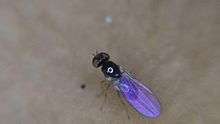Asteiidae
| Asteiidae | |
|---|---|
 | |
| Asteia amona from Walker Insecta Britannica Diptera | |
 | |
| Asteia wing veins | |
| Scientific classification | |
| Kingdom: | Animalia |
| Phylum: | Arthropoda |
| Class: | Insecta |
| Order: | Diptera |
| Superfamily: | Opomyzoidea |
| Family: | Asteiidae Loew |
| Subfamilies | |
| |


Asteiidae is a small but widespread family of acalyptrate flies or Diptera. About 130 species in 10 genera have been described worldwide.They are rarely collected.
Family description
For terms see Morphology of Diptera.
Adult asteiids are minute to small (1–3 millimeters) thin-bodied and delicate (often weakly sclerotized) flies, with yellow-black or dark colours.The wings are relatively long and transparent. The head is rounded, the male almost always with distinct interfrontal stripes. The arista may be bare or pubescent but usually has a zigzag of longer and shorter alternating rays. The postvertical bristles are weakly developed, divergent or parallel or totally absent. Ocellar bristles may be present or absent. There is one orbital bristle on each side of the frons (Shtakel'berg] (0–2 pairs of frontal bristles). Interfrontal bristles may be present as may scattered interfrontal setulae. Vibrissae may be absent or present. On the mesonotum are one to two pairs of dorsoscentral bristles. The costa is entire, without interruptions; the subcosta is reduced; posterior basal wing cell and discoidal wing cell are fused; anal cell of wing and anal vein of wing are absent. Tibiae lack a dorsal preapical bristle.
Biology
Adults are often found on flowers and low vegetatation but have been collected at windows indoors and on tree wounds. In one genus (Leiomyza) adults are found on mushrooms and bracket fungi. Adults of the species Astiosoma rufifrons Duda are attracted to wood ash after bonfires especially at evening. Larval biologies are unknown, but adults have been reared from fungi (Leiomyza), stalks of Cannabis sativa, flower buds, and dried reed stems. Sabrosky (1987) suggested that the larvae may be scavengers in the frass of other insects.
Species Lists
- Palaearctic
- Nearctic
- Japan One species
Identification (Literature)
Sabrosky, C.W., 1943. New genera and species of Asteiidae (Diptera), with a review of the family in the Americas. Annals of the Entomological Society of America: 36(3):501-514. Available online at the Core Historical Literature of Agriculture, Albert R. Mann Library, Cornell University.
Sabrosky, C.W., 1956. Additions to the knowledge of Old World Asteiidae.Revue francaise d'entomologie (Nouvelle Serie) 23:216-243.
Authorship
The family Asteiidae was erected by Hermann Loew
Phylogeny
| Opomyzoidea |
| ||||||||||||||||||||||||||||||||||||
| |
Images
- Encyclopedia of Life World taxa list and images
References
- ↑ Nello schema di McAlpine, i Clusiidae sono in relazione con il genere Acartophthalmus, che secondo l'analisi cladistica di Buck (2006) va collocato nel clade dei Carnoidea. Vedi Acartophthalmidae.
- Duda. 1934. Astiidae. In: Lindner, E. (Ed.). Die Fliegen der palaearktischen Region 6, 1, 58b, 1-15. Keys to Palaearctic species but now needs revision (in German).
- Papp, L. 1998. Family Asteiidae. In: Papp, L. and Darvas, B.: Contributions to a Manual of Palaearctic Diptera. 3: 295-303. Science Herald, Budapest.
- Papp L., 1984. Family Asteiidae. In: Soós Á. & Papp L. (eds.), Catalogue of Palaearctic Diptera, 10. Akadémiai Kiadó, Budapest - Elsevier, Amsterdam: 63-66.
- Shtakel'berg, A.A. Family Asteiidae in Bei-Bienko, G. Ya, 1988 Keys to the insects of the European Part of the USSR Volume 5 (Diptera) Part 2 English edition.Keys to Palaearctic species but now needs revision .